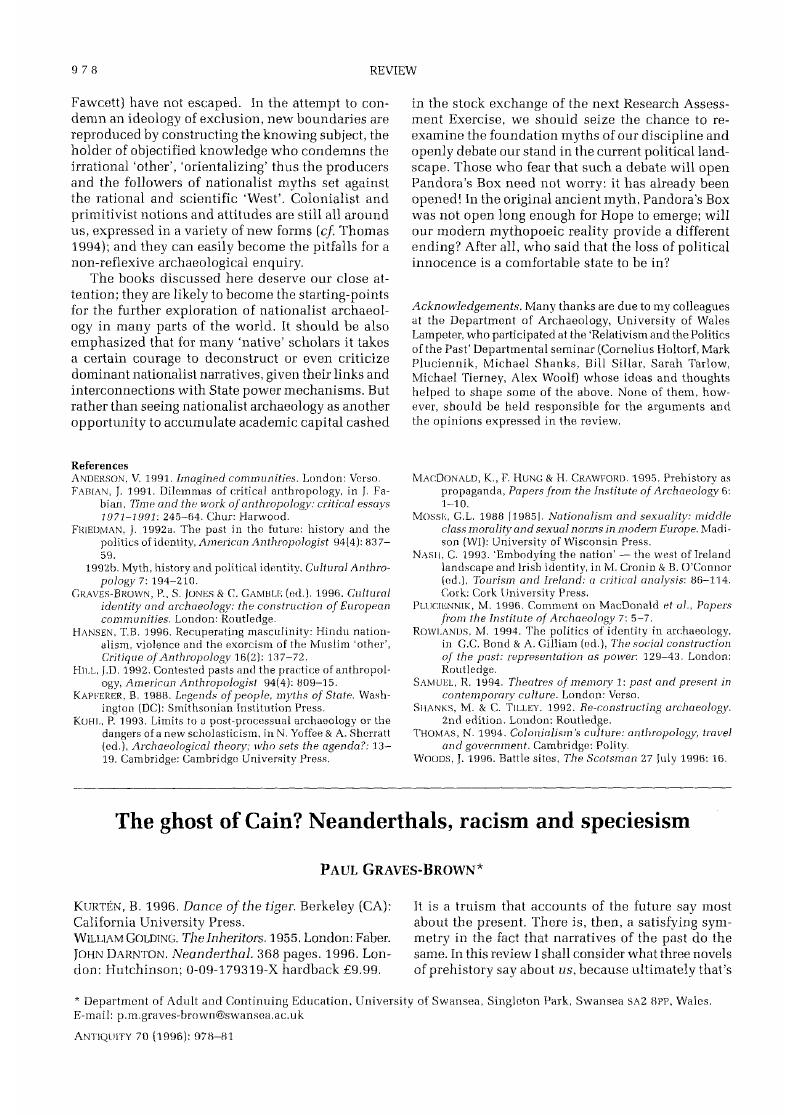No CrossRef data available.
Article contents
The ghost of Cain? Neanderthals, racism and speciesism
Published online by Cambridge University Press: 02 January 2015
Abstract
An abstract is not available for this content so a preview has been provided. Please use the Get access link above for information on how to access this content.

- Type
- Review articles
- Information
- Copyright
- Copyright © Antiquity Publications Ltd. 1996
References
Graves, P. M.
1991. New models and metaphors for the Neanderthal debate,
Current Anthropology
32(5):513-42.Google Scholar
Graves-Brown, P.M.
1994. The Borges matrix. A serendipitous bibliographical narrative, Online Archaeology: http://avebury.arch.soton.ac.uk/Joumal/Graves/graves.html
Google Scholar
Graves-Brown, P.M.
1996a. Ape and essence, in Pettit, P. & Lake, M., The Hierarchies of being human, Archaeological Review from Cambridge (thematic edition).Google Scholar
Graves-Brown, P.M.
1996b. All things bright and beautiful, in Graves-Brown, P. M., Jones, S. & Gamble, C. S. (ed.), Archaeology and cultural identity: the construction of European communities. London: Routledge.Google Scholar
Hull, D. L.
1984. Historical entities and historical narratives, in Hookway, C. (ed.), Minds, machines and evolution: 17–43. Cambridge: Cambridge University Press.Google Scholar
Ingold, T.
1995. ‘People like us’. The concept of the anatomically modern human,
Cultural Dynamics
72(2):787–214.Google Scholar
Mellars, P.
1996
The Neanderthal legacy — an archaeological perspective from western Europe. Princeton (NJ): Princeton University Press.Google Scholar
Stringer, C. B. & Gamble., C. S.
1993. In search of the Neanderthals.
London: Thames & Hudson.Google Scholar
Tattersall, I.
1995. The last Neanderthal — the rise, success, and mysterious extinction of Our Closest Human Relatives.
London: Macmillan.Google Scholar
Tester, K.
1991
Animals and society: the humanity of animal rights. London. Routledge.Google Scholar
Thomas, J.
1991
The hollow men? A reply to Stove Mithen, Proceedings of the Prehistoric Society
57(2):15–20.Google Scholar
Trinkaus, E. & Shipman, P.. 1993. The Neanderthals: changing the image of mankind.
London: Cape.Google Scholar
Wells, H. G.
1958. (1921). ‘The grisly folk’, in Wells, H. G.. Selected Short Stories:
258-99. Harmondsworth: Penguin.Google Scholar
Wolpoff, M.
1989. Multi-regional evolution: the fossil alternative to Eden, in Mellars, P. & Stringer, C. B., The human revolution: behavioural and biological perspectives on the origin of modern humans:
62–108. Edinburgh: Edinburgh University Press.Google Scholar




